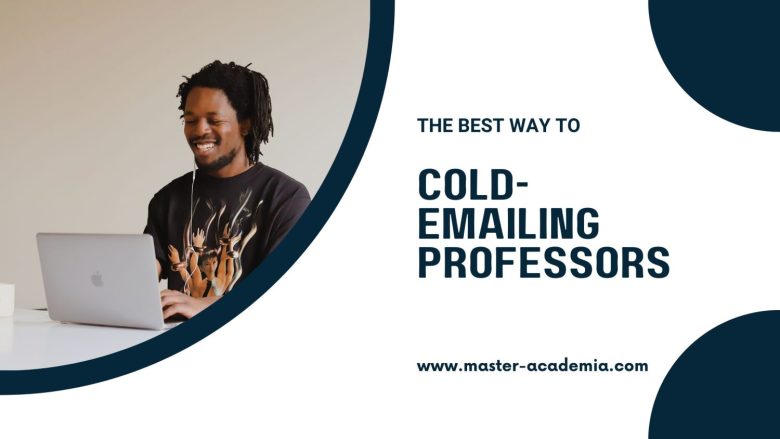
Cold emails often carry a negative reputation. However, there are several compelling reasons why cold emailing professors can be beneficial. Learning the proper way to write cold emails can significantly increase your chances of receiving a reply. Explore more about cold emailing in academia, along with alternative strategies to connect with professors when you don’t have prior contact.
Contents
What is cold emailing?
You might be more acquainted with the concept of cold calling, where you make unsolicited phone calls to people ‘out of the blue.’ In comparison, cold emailing is generally considered less intrusive since the recipient has the option to simply ignore your request or message.
Cold emailing involves reaching out to someone via email without any prior contact, essentially initiating communication with an individual who is unfamiliar with you and hasn’t requested or anticipated your message.
However, opinions on cold emailing vary significantly. Some view it as an effective way to connect with others and expand their network, while others perceive cold emailing as impolite or even akin to stalking.
Determining whether cold emailing is appropriate or not in academia is difficult. Personal opinions on cold emails diverge widely. Your success with cold emails may vary depending on individual professors; some may respond positively, while others may not.
Reasons to cold email professors in academia
There are occasions when cold emails might be the only way to get in touch with someone. The most common reasons to cold email professors in academia are:
- Requests for thesis supervision. Many cold emails revolve around the topic of thesis supervision. This can encompass master thesis supervision, although to a lesser extent, and primarily focuses on PhD supervision. Regarding the latter, these requests frequently include inquiries about potential job or scholarship opportunities.
- Inquiry about job opportunities. Individuals who want to continue their studies at the PhD level, and have a specific institution and supervisor in mind, often revert to cold emails. Similarly, PhD students who are near the end of their dissertation might reach out to professors to inquire about postdoctoral and other academic positions.
- Inquiry about internship opportunities. In recent years, it has become much more common for students in undergraduate and graduate programs to do research internships at academic institutions. Sometimes, these are internships abroad. Cold emails often inquire about research internship opportunities ranging between a few weeks and several months.
- Requests for collaboration, for instance in a grant proposal. In a competitive job market with limited job opportunities, acquiring grants to create new positions has become a popular strategy. Furthermore, grant proposal writing can bolster early career researchers’ academic CVs. Many grant proposals involve a team of researchers, and cold emailing can be a strategy to approach ‘big names’ from your discipline without having had any prior contact.
- Request for participation in a seminar, panel or roundtable discussion. In line with the quest for establishing all-round academic profiles, organizing seminars, panels or roundtable discussions, but also webinars or podcasts is a common academic activity next to research and teaching. Frequently, cold emails invite professors to participate in these types of activities.
How to cold email professors
The success of cold emails can depend on the format and content of the email. The key is to keep it short, formal and to the point.
Imagine a professor receiving 50-100 emails per day. They will not read an email that is 2000 words long to figure out who you are and what you want. Therefore:
- Develop a crystal-clear email subject (For example: “Exploring internship opportunities in your research group“, “Invitation to participate in the roundtable discussion“, “Exploring opportunities for PhD supervision“…)
- Formal salutation (The formal salutation should be adjusted according to the rank of the email receiver in the university hierarchy. Furthermore, always go for the more formal option, such as “Dear Professor Dr. …, ” instead of “Hey John“)
- Short introduction of who you are (And I mean short. For instance: “I am a third-year PhD student at Georgetown University, specializing in forensic sciences. For further information on my work, please find my resume attached.” Attach your resume if you look for supervision, job or research opportunities.)
- Purpose of your email (Reiterate the purpose of your email, as stated in the subject line. Specify why you contact them specifically, and make it personal. You don’t want to make the impression as if you are sending generic emails to hundreds of people. Furthermore, if you reach out to inquire about supervision, collaboration or participation in an event or activity, provide a very short summary, and attach a more elaborate 1-page summary to your email.)
- Action points (Specify what you want from the email recipient: A response on whether they are interested in your proposal or not? A confirmation of participation? To set up a short meeting? Etc.)
- A proper email ending (A proper email ending consists of an ending phrase, sign-off and an email signature)
And finally, a bonus tip: Very often, the recipient might be interested in your proposal but needs to know the financial situation behind your plan or suggestion. Providing this information from the get-go shows that you are aware of this point and can avoid lengthy email conversations.
Circumstances to consider when cold emailing
Academics are well-known for their busy schedules, handling multiple tasks simultaneously. Considering this, it’s crucial to be mindful of teaching-heavy periods, as responses to your cold email might be delayed during those times. If your request doesn’t have immediate time constraints, it could be beneficial to check the academic calendar of the recipient’s institution for teaching-free exam weeks. Sending your email during these periods might increase the likelihood of a favorable response.
It’s also important to understand that prominent professors, especially those with numerous publications, often receive numerous cold emails. Additionally, they may already have a substantial number of PhD students under their supervision. As a result, you might have a better chance of getting a response by cold emailing lecturers, assistant professors, or senior lecturers and associate professors.
Lastly, even if you compose the perfect cold email, there is still a chance that you won’t receive a response. While it can be disappointing, don’t be discouraged. Sending a friendly reminder after two weeks of no response is acceptable. However, if silence persists, it’s best to move on and explore other opportunities.
Alternatives to cold emailing
Establishing connections through your network often yields higher success rates than cold emailing. If possible, inquire within your current environment (colleagues, course lecturers, professors) if anyone knows the person you wish to contact. If there is a mutual connection, kindly ask for an introduction. This can be a great way to establish a network for introverted individuals.
If you feel uncomfortable directly asking around in your current environment, consider checking if the person you want to contact is on LinkedIn. If you have mutual connections, reach out to them and politely request an introduction.
However, it’s essential to be cautious about cold emailing, even if it proves successful. The personal relationship between the supervisor and PhD student, significantly impact the successful completion of a PhD. Admiring a professor’s academic work does not necessarily guarantee a compatible personal dynamic.
To increase the chances of a response, consider organizing a small, concrete activity like a seminar, discussion session, or webinar. This approach offers two advantages: First, you approach the person with specific and time-limited ideas, making it more likely to receive a response as you have something valuable to ‘offer’. Second, a short collaborative activity helps you assess compatibility and determine if you can work effectively together for an extended period.



